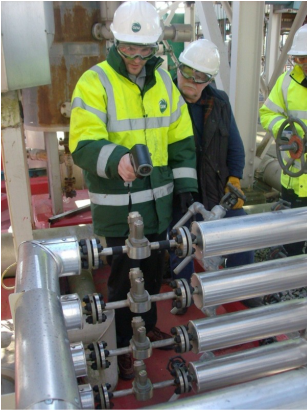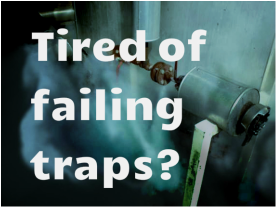 Steam has been a valuable source of power since the industrial revolution. Contrary to what people believe steam is still one of the most efficient and convenient ways of distributing high quality heat energy; however, if systems are not maintained properly they can be wasteful, inefficient and dangerous. With the never-ending cycle of steam wastage most companies fail to realize that proper steam trap testing and maintenance can reduce their fuel bills by 10-30%. As steam travels through pipework and industrial applications it loses energy to surfaces and condenses. This condensate must be removed without leakage of live steam to keep the system at full efficiency. A steam trap must remove condensate from a system as quickly as possible without leaking precious live steam. As well as keeping the system efficient the steam trap helps to prevent water hammer. If you are familiar with steam traps then you know that they can be a pain to manage and maintain. Around 10% of steam traps fail each year due to wear of mechanical parts. Oversized traps can also allow steam to escape which can cause further damage by wiredraw as steam takes the fastest path to escape to a lower pressure area cutting a path as it flows. This amounts to an average of 15% energy wasted through failed traps and condensate/flash loss. In order to get maximum efficiency from the system, steam traps need to be tested properly and regularly. These methods need to be easy to use as traps are often in confined locations and hard to access. The two most common forms of testing are thermography and ultrasonic. Both can be conducted on site with compact lightweight tools and the results can be analysed immediately. This allows problems to be identified and investigated fully to give a better understanding of the entire system and all its inefficiencies. Ultrasonic measurements are usually more accurate but can be more time consuming. Ultrasonic frequencies in the trap are converted into the audible range by a probe for analysis by ear. In general steam traps work in a cycle. They contain a valve that is closed when steam is present in the trap and open when condensate is present. The duration of the cycle varies by trap and load. By listening for the distinctive cycles of a low volume period as the trap is filling with condensate and a louder rushing sound as condensate discharges we can check that the trap is working correctly. For thermodynamic and inverted bucket steam traps there is a very clear on/off cycle that can be heard under almost all loads. Other types of trap including float, thermostatic and bimetallic all cycle between a higher and lower volume but do not have a distinct on and off. At low loads such as line drainage on insulated lines this cycle can be even less distinct. They sound like a dribble on light load and modulate on higher loads. Bimetallic traps respond even slower than the other traps making it even harder to distinguish between the cycles.  Venturi-orifice traps operate on a completely continuous principle with no cycle. Therefore these traps cannot be tested with ultrasonic measurements as there is no distinction to be heard. The orifice in these traps is smaller than in other types and so the same quantity of condensate discharges at a faster speed. The sound level in these traps is higher due to the speed of condensate and restriction of flash expansion in the throat. When ultrasonic testing is used on such traps they can incorrectly be identified as failed open. However, the performance of venturi-orifice traps can be verified using thermography as described below. In order to use thermography efficiently you need to collect vital information about steam pressure including local variations, reductions and back pressure from lifts and flash heat recovery. The temperature upstream and downstream of the trap must be taken and compared with the values on the steam tables for the given pressures. If temperatures upstream are lower than expected it could be because the trap is blocked and is backing up condensate. If however temperatures are higher downstream than expected it indicates that the condensate return line is pressurized. This could result from passing steam, undersized condensate lines or an obstruction.
Generally for line drainage type applications this method is accurate. If however you have a low temperature process; for example an air handling unit heating air to 50°C, the steam condenses but still has enough energy as condensate to heat the air. The control valve will open and close to control the level of condensate in the process but not enough to completely drain it. In this case the trap will only ever contact steam during start-up and does nothing during normal operation. The trap will run flooded and seem to be blocked but is actually working properly. Another problem may be when several steam traps in close proximity all feed into the same condensate line. If one of these traps fails it will pressurize the condensate line with live steam. The temperature after each trap will be higher than expected due to the one failed trap and finding it may be tricky. By using these methods in unison and understanding the processes a picture can be built up of the entire steam system. Thermography allows you to get a fast response that finds majority of failed traps. Any inconsistencies can be investigated further by an ultrasonic probe with the exception of venturi-orifice traps. This is because they discharge condensate continuously so can be tested only by thermography. Using the right equipment allows you to monitor your traps efficiently and maintain them accordingly, resulting in steam and energy savings.
1 Comment
|
Archives
August 2021
Categories
All
|

 RSS Feed
RSS Feed